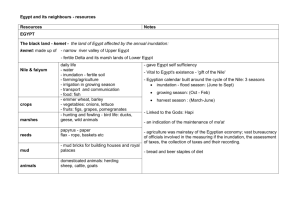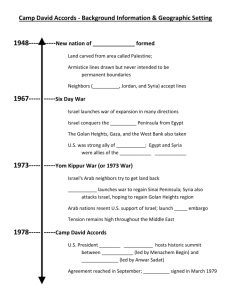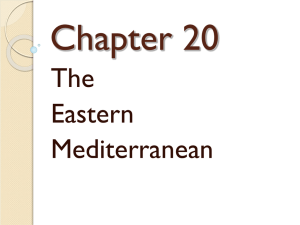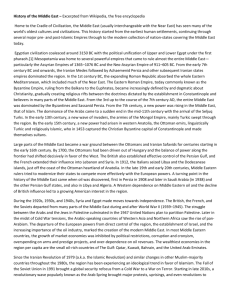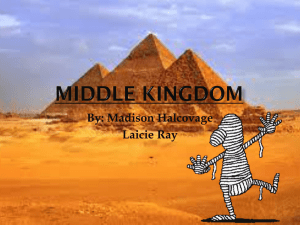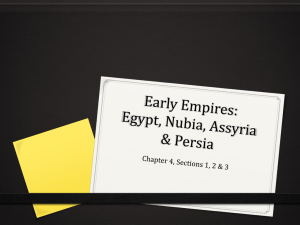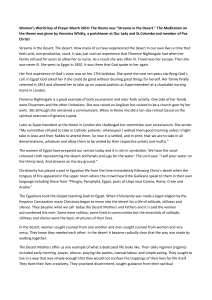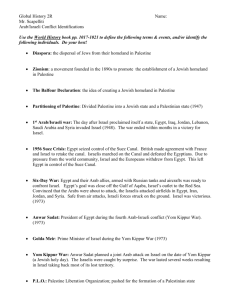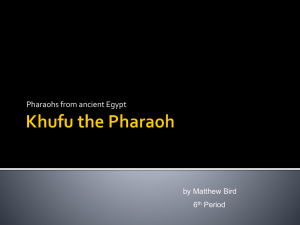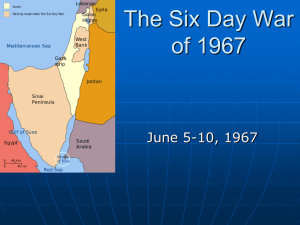History of Ancient Middle East
advertisement
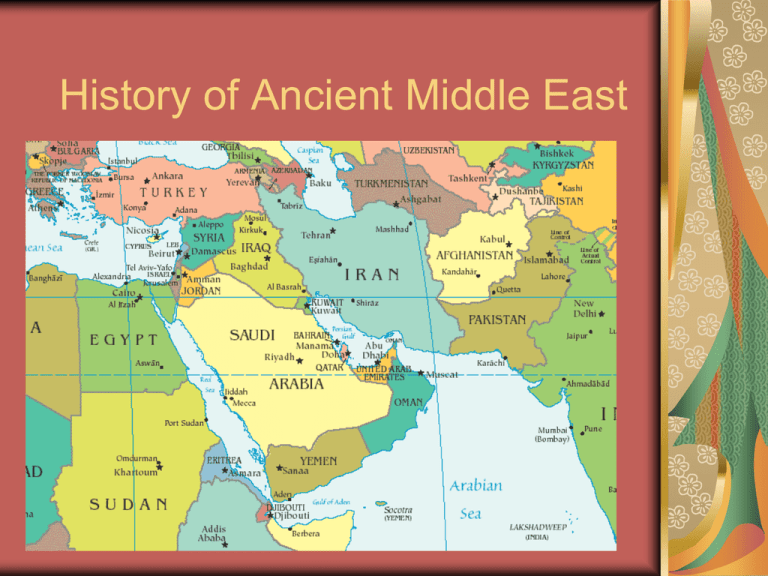
History of Ancient Middle East Who lives here? Share common history, but not a common culture Majority practice Islam: Sunni (followed elected leader – chosen in a shura) Shiite (followed Ali, cousin of Muhammad) (Israel is the exception – What do they practice?) There are also Christian communities Religious identity is closely tied to social status Geography DRY – mostly desert Mountain valley, river valleys and oases Landforms Sahara desert – world’s largest hot desert Atlas mountains in North-west Africa Desertification -Process by which arable land becomes desert -Overgrazing strips land of plant life and exposes soil Mountains Often they block moisture coming in off of the Mediterranean, Black and Caspian Seas Bosporus, Sea of Marmara, and Dardanelles have strategic importance… can you guess why? Irrigation Not much arable land – Irrigation needed to sustain agriculture and life in many areas in the Middle East Problem: Too much salt in the soil is drawn up with water, when water evaporates it destroys soil Rivers Nile – the lifeline of Egypt 96% of Egypt is desert, practically unlivable Floods regularly Tigris & Euphrates River valley formed basis for first civilization Industry Cash crops – ie: cotton, tobacco on coastal regions Traditional rug making Illiteracy stands in the way of wide-spread industrial success Service Industry – banking, tourism, and communications Desalination – trying to solve water shortage OIL OPEC Venezuela joined with several Middle Eastern states to form the Organization of Petroleum Exporting Countries Operates as a cartel – members work together to limit competition and maintain prices Fertile Crescent Heavier rainfall and access to water Extends along Mediterranean Coastal plain in Israel, through Lebanon and Syria, down into northern Iraq Ancient civilizations began here – Mesopotamia in 4,000B.C. Civilizations of the Middle East In the following slides, you will see some of the civilizations that have occupied portions of the Middle East through time. Accomplishments are listed with each civilization. After looking at the civilizations and reading the text book pages, come up with one question concerning the History of the Middle East that you think should appear on a future test. Also, choose which civilization you believe had the biggest impact on this region and why Egyptians 5,000 BC Developed trade of crafts Pharaoh – ruled as god-king Hieroglyphics Amazing architecture, result of concern with life after death Sumerians Polytheistic, built Ziggurats as temples to the gods, as well as administrative centers Developed Cuneiform to keep records Warfare broke out over control of land and water Babylonians Empire in T&E river valley Hammurabi – 1st ever public law code, didn’t create equality but prevented the strong from destroying the weak This is where the saying “an eye for an eye comes from”…literally Hittites, Lydians, Phoenicians Hittites used iron – (stronger metal than what they had before, but brittle) Lydians 1st to use coined $ Phoenicians lived in Lebanon, traders and navigators, developed alphabet Hebrews Adopted idea of monotheism One God - Yaweh Old Testament 10 commandments God demands obedience and in turn, protects his people Diaspora – the forced removal of Jews from their homeland Hebrews migrated from Palestine due to famine and were enslaved in Egypt – freed by Moses according to Bible Settled in Canaan and set up kingdom of Israel Israel split up by Assyrians and Babylonians – many Jews were exiled, this was the first Diaspora (586 BC) Persians Conquered huge empire by 500 BC Built roads, “pony express” communication system Lots of cultural diffusion Greeks and Romans Alexander conquers Persia, tried to unite the Greek and Middle Eastern worlds Greek education and culture is spread through the Middle East – more cultural diffusion Romans exerted control over Egypt, Syria and Turkey Byzantine Rome divided, Constantinople became center of Christianity in Byzantine Empire (Eastern Rome) Fell to Ottoman Turks Crusades 200 years of warfare Fought for control of the Holy Land (Palestine) Crusaders robbed land and goods, killed Muslims and Jews Ottomans Suleiman the Magnificent Ruled from 15th to 18th century Turks from Turkey Good soldiers and administrators, unified most of the Middle East, North Africa and Southeastern Europe under their control Ghazis – warriors who defended Islam in the region Built mosques, created literature, became powerful empire Ruled by a Sultan Education, religious matters and laws controlled by mullahs 18th century corruption in govt. and loss of trade routes lead to decline in empire’s land and power Napoleon, the Brits and the Russians Beginning of European infiltration into M.E. After he defeated Egypt, the British came to the defense of Ottomans – shows them as superior and gave them voice in M.E. affairs Brits also defend Turkey from Russia Nationalism on the Arabian Peninsula Wahhabis – Anti-Turkish, AntiWestern Muslim movement Angry @ corruption of Ottoman govt. and western reforms Urged strict puritanical devotion to Islam Helped to establish Saudi Arabia WWI France and Britain take parts of the M.E. in the 1800s. British occupy Egypt and control canal Broken promises of Europeans after the war is won create bitterness Brits had promised M.E. countries independence if they helped After victory, Lebanon and Syria went to France while the British took over Iraq, Palestine, and Transjordan, (as mandates) Growth of nationalism results from resentment of European rule and manipulation – demands for independence grow Sykes-Picot Agreement, 1916 Nationalism Mass rallies, strikes and boycotts Arabs engaged in guerilla warfare in Palestine and violent outbursts occur in occupied countries Saudi Arabia and Iraq gain independence, Syria and Lebanon controlled by French until WWII Opportunity Knocks Britain defends its interests in Egypt in WWII from Italian dictator Mussolini Arabs in the rest of occupied countries try to ally with Axis powers Try to seize opportunity to be rid of European domination Map of History of Empires http://www.mapsofwar.com/images/E MPIRE17.swf Describe one possible result of the information you gather from the map.

